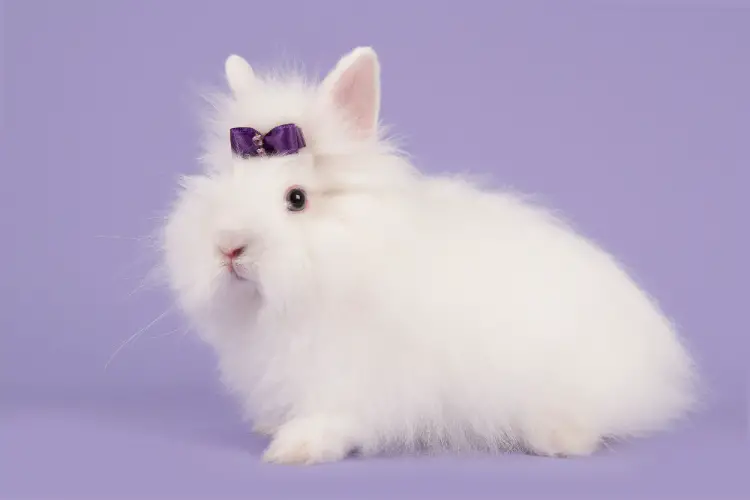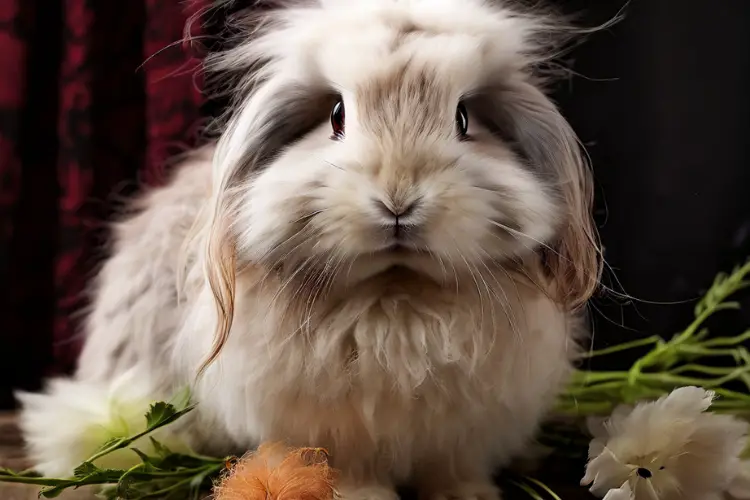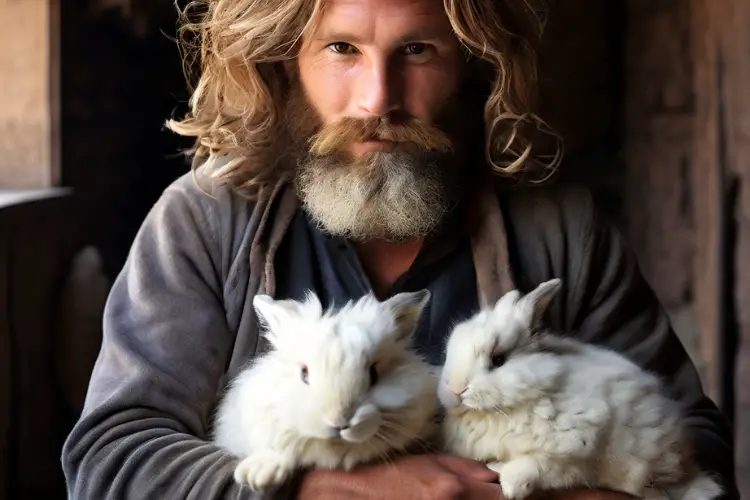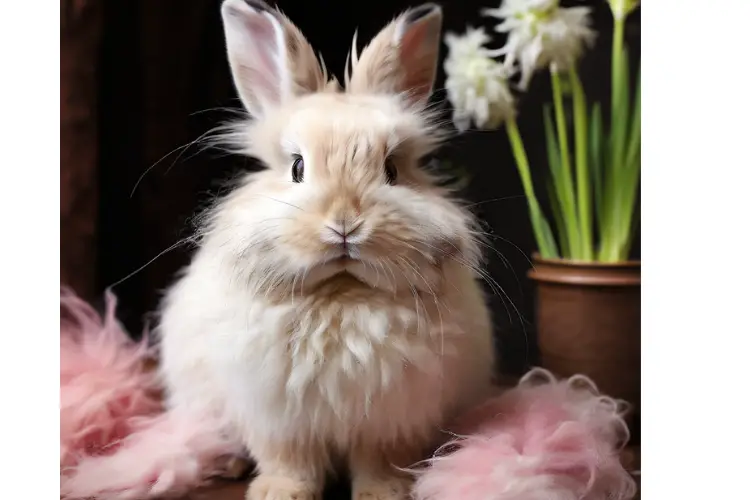Angora Rabbit Grooming and Shearing is a comprehensive guide designed to help pet owners understand the unique grooming needs of their fluffy companions. Angora rabbits are not only adorable but also require diligent care, particularly in maintaining their luxurious fur.
In this blog post guide, we will explore the various aspects of grooming, health, and overall welfare to ensure your Angora rabbit remains healthy, happy, and well-groomed.
Key Takeaways
- Regular grooming of Angora rabbits is crucial to prevent matting and wool block, a condition caused by the ingestion of fur.
- Specialized grooming tools, such as a slicker brush, are essential for effectively working through the dense fur of Angora rabbits.
- Grooming is closely tied to the health of Angora rabbits, helping to prevent common issues like dental problems and skin infections.
- Angora rabbits require a committed caregiver who is willing to undertake frequent grooming sessions, which are necessary for the rabbit’s well-being.
- Starting grooming habits early in a rabbit’s life and using proper techniques can help both the pet and owner adapt to a regular grooming routine.
Understanding Angora Rabbit Grooming Needs
The Importance of Regular Grooming
Regular grooming of Angora rabbits is not just about keeping them looking their best; it’s a critical aspect of their health and well-being. Daily grooming prevents the formation of mats and tangles, which can lead to skin infections and discomfort for your rabbit. Moreover, it allows for the early detection of potential health issues such as parasites or skin sores.
Grooming is also a bonding time between you and your rabbit, helping to build trust and a sense of security.
Here’s a quick overview of the daily grooming essentials:
- Brushing: Using a gentle bristle brush to remove loose fur and prevent matting.
- Skin and Coat Examination: Checking for mites, sores, or signs of matting.
- Nail Clipping: Keeping their nails trimmed to avoid overgrowth and injury.
Remember, starting grooming habits early with short, frequent sessions can make the process easier for both you and your rabbit as they grow. Maintenance includes regular shearing to keep the wool at an optimal length and paying extra attention to areas prone to matting. Keeping a record of each grooming session can help you stay organized and ensure your rabbit’s coat remains in excellent condition.
Grooming Frequency and Techniques
Angora rabbits are renowned for their luxurious wool, which necessitates a consistent and thorough grooming routine. Daily grooming is not just recommended; it’s essential to prevent the serious condition known as wool block, where rabbits ingest their own fur, leading to digestive issues.
Grooming an Angora rabbit is a commitment that involves regular brushing, skin and coat examination, and nail clipping to maintain their health and comfort.
Here’s a quick overview of the grooming steps:
- Brushing: Start with a gentle bristle brush to remove loose hairs and prevent matting.
- Skin and Coat Examination: Check for signs of mites, sores, or matting during each session.
- Nail Clipping: Incorporate nail trimming into the routine to avoid overgrowth and associated problems.
For young rabbits, begin with short, frequent grooming sessions to establish good habits early on. As they mature, their shedding increases, making the grooming process more intensive. Remember, grooming is not just about aesthetics; it’s a critical aspect of an Angora rabbit’s health regimen.
Specialized Tools for Effective Grooming
To achieve the secret to perfect grooming, it’s essential to select the right tools tailored for the delicate fur of Angora rabbits. A gentle bristle brush is indispensable for the removal of loose fur, while a wide-toothed metal comb can detangle without causing discomfort. For a more thorough grooming, the slicker brush reaches into deeper layers of fur.
For precise trimming tasks, Angora-specific grooming scissors are a must-have, ensuring both safety and precision. Regular shearing, with the wool length kept between 8-12 centimeters, can prevent tangling and matting, especially in hotspots like the belly and behind the ears. Maintenance of these tools is just as important as their use; keeping them clean and in good condition will extend their lifespan and effectiveness.
In addition to the right tools, maintaining a consistent grooming schedule is crucial. Documenting each session helps in tracking the rabbit’s health and grooming needs over time.
Health and Welfare of Angora Rabbits
Common Health Issues and Prevention
Angora rabbits, with their luxurious wool, are susceptible to several health issues that require vigilant prevention strategies. Wool block is a common condition where rabbits ingest their own fur, leading to intestinal blockage. This can be managed with proper grooming and a suitable diet. Dental problems and skin infections, often concealed by their dense coat, also necessitate regular check-ups.
To ensure the health and longevity of Angora rabbits, it is crucial to adopt a comprehensive grooming and care regimen. This includes frequent shearing, attention to matting hotspots, and a cool environment during hot weather to prevent heat stroke.
Preventative measures are as important as treatment, and include:
- Health screenings for breeding rabbits to avoid hereditary diseases.
- Maintaining spacious habitats that allow for natural behaviors.
- Keeping detailed grooming records to monitor the rabbit’s condition over time.
By adhering to these practices, owners can significantly reduce the risk of common health issues and contribute to the overall welfare of their Angora rabbits.
The Connection Between Grooming and Health
The health of an Angora rabbit is closely tied to its grooming regimen. Regular grooming not only keeps the coat in prime condition but also serves as a preventive measure against various health issues. For instance, failure to remove excess fur through grooming can lead to intestinal blockage, a serious condition that requires careful management through proper grooming and diet.
Grooming sessions provide an excellent opportunity to check for early signs of health problems, such as mites, sores, or matting. This proactive approach can prevent minor issues from escalating into major health concerns.
Additionally, Angora rabbits are susceptible to heat stroke due to their dense fur. Maintaining a cool environment during hot weather is crucial, and grooming plays a significant role in ensuring their comfort and safety. By keeping the wool length between 8-12 centimeters through regular shearing, owners can help prevent tangling and overheating.
- Gentle Bristle Brush: For effective removal of loose fur.
- Wide-Toothed Metal Comb: To detangle without pulling.
- Slicker Brush: For deeper layer grooming.
- Angora-Specific Grooming Scissors: For trimming tasks, ensuring safety and precision.
Creating a Safe and Comfortable Environment
Providing a safe and comfortable environment is crucial for the well-being of Angora rabbits. Their living space should be clean, dry, and spacious enough to allow for exercise and natural behaviors. It’s important to remember that these rabbits thrive in habitats that are safe and quiet, with plenty of space to hide and play.
- Daily interaction with your Angora rabbit is essential for their emotional health. Gentle handling and regular play keep them tame and mentally stimulated.
- Health screenings for breeding rabbits are important to prevent hereditary diseases and maintain the breed’s integrity.
- Habitat considerations should include ample room for the rabbits to exhibit natural behaviors, contributing to a higher quality of life.
Ensuring that your Angora rabbit’s habitat mimics their natural preferences as much as possible will make them feel more at home. This includes areas with grass and bushes or suitable alternatives within their enclosure.
Cooperation with conservation organizations can also play a role in enhancing the genetic pool of the Angora breed, which is beneficial for both the rabbits and the owners. By taking these steps, owners can create a nurturing environment that promotes the health and happiness of their furry companions.
The Grooming Process Explained
Step-by-Step Grooming Guide
Grooming your Angora rabbit is a delightful yet essential activity that ensures the health and happiness of your fluffy companion. Begin with a gentle bristle brush to remove loose fur without causing discomfort. Follow up with a wide-toothed metal comb to carefully detangle the wool, and use a slicker brush for a thorough grooming of the deeper layers.
Regular grooming is not just about keeping your rabbit looking good; it’s a fundamental part of their overall care.
For those areas prone to matting, such as the belly and behind the ears, give extra attention during your grooming routine. It’s also important to maintain the wool length between 8-12 centimeters to prevent tangling and matting. Here’s a simple guide to follow:
- Brushing: Gently brush the rabbit’s wool to remove loose hairs and prevent matting.
- Skin and Coat Examination: Check for any signs of mites, sores, or matting.
- Nail Clipping: Regularly trim their nails as part of the grooming routine.
Keeping records of each grooming session with the date and details will help you stay on top of your rabbit’s grooming needs and monitor their health over time.
Handling Mats and Tangles
Dealing with mats and tangles in an Angora rabbit’s coat requires patience and the right technique. Regular brushing is essential to prevent mats from forming. When mats do occur, they should be addressed promptly to avoid discomfort and potential health issues for the rabbit.
- Start by gently separating the mat with your fingers.
- Use a wide-toothed comb to carefully work through the tangle.
- Avoid pulling on the skin by holding the base of the fur as you comb.
- For stubborn mats, a mat splitter or de-matting tool may be necessary.
Remember, never cut a mat out with scissors as this can cause injury to the rabbit’s delicate skin.
Keeping a grooming log can be helpful in maintaining the health of your Angora’s coat. Note the date, tools used, and any particular areas of concern. This record-keeping can be invaluable for monitoring the rabbit’s grooming needs and ensuring a consistent routine.
Nail Trimming and Skin Care
Proper nail trimming and skin care are essential for the health and comfort of your Angora rabbit. Regular nail clipping is necessary to prevent overgrowth, which can lead to difficulty walking and potential injury. When trimming, be cautious to avoid the quick, the pink area within the nail where blood vessels and nerves are present.
- Nail Trimming Tools: Use a specialized pet nail clipper or grinder designed for small animals.
- Frequency: Check nails monthly, trimming as needed to maintain a proper length.
- Handling: Gently restrain your rabbit, providing comfort and stability during the process.
Skin care involves regular checks for any signs of irritation, mites, or sores. A healthy diet and clean living conditions contribute significantly to skin health. If any abnormalities are found, consult with a veterinarian promptly.
Remember, grooming is not just about aesthetics; it’s a critical component of your rabbit’s overall well-being. Consistent grooming routines ensure that your rabbit remains happy and healthy.
Angora Rabbits as Pets: What to Expect
Temperament and Compatibility with Owners
Angora rabbits are cherished for their docile and sweet temperaments, making them excellent companions for those who appreciate a calm pet.
They are sociable creatures that thrive on interaction and can form strong bonds with their caregivers. Regular grooming sessions not only keep their luxurious fur in top condition but also serve as a delightful bonding activity, as these rabbits enjoy the attention they receive during such care.
Proper handling is essential; Angoras are gentle and can be shy, responding best to calm and measured movements. They are adaptable animals but require an environment that offers a balance of stimulation and rest. This ensures their well-being and maintains their serene demeanor.
Compatibility with owners is key for a harmonious relationship. Angora rabbits are best suited to individuals or families who understand their specific needs and are committed to providing the necessary care and attention.
Owners should be prepared for the commitment that comes with an Angora rabbit. Their grooming needs are non-negotiable, and their environment must cater to their sociable yet calm nature. With the right care, these rabbits can be a source of joy and companionship in any home.
The Commitment to Grooming and Care
Owning an Angora rabbit comes with a significant commitment to grooming and care. Daily grooming is not just recommended; it is essential for the well-being of these unique pets. The dense and luxurious coat of an Angora rabbit can quickly become a haven for mats and tangles if not properly maintained.
The grooming routine for an Angora rabbit is comprehensive and requires a systematic approach. It’s not merely about aesthetics; it’s about health and comfort.
To ensure the coat remains in prime condition, owners should adhere to a grooming schedule that includes brushing, skin and coat examination, and nail clipping. Here’s a quick overview of the daily grooming requirements:
- Brushing: Gently brush the rabbit’s wool to remove loose hairs and prevent matting.
- Skin and Coat Examination: Regular checks for mites, sores, or matting are crucial.
- Nail Clipping: Keeping their nails trimmed is an integral part of the grooming routine.
Additionally, regular shearing is necessary to keep the wool length manageable, typically between 8-12 centimeters. Special attention should be given to areas prone to matting, such as the belly and behind the ears. Keeping detailed records of each grooming session can help owners stay organized and ensure no aspect of care is overlooked.
Selecting the Right Rabbit for Your Home
When you decide to welcome an Angora rabbit into your home, it’s essential to choose a rabbit that fits well with your lifestyle and expectations. It is friendly and docile but also playful and alert, making it a suitable companion for those who desire a hands-on pet. However, not all rabbits will be ideal for every owner, so consider the following points:
- Research: Start by researching breeders online and look for reviews and testimonials.
- Reputability: A reputable breeder will prioritize the health and well-being of their rabbits.
- Visit: If possible, visit the breeding facility to observe the environment and the care given to the rabbits.
When selecting an Angora rabbit, it is crucial to consider the source and the financial aspect of the acquisition. We’ll guide you through choosing a reputable breeder and understanding the pricing to ensure you make an informed decision.
Remember, the initial cost is just one part of the overall commitment. Owning an Angora rabbit involves ongoing expenses for grooming, healthcare, and proper nutrition. By taking the time to select the right rabbit from a responsible breeder, you’re laying the foundation for a rewarding relationship with your new pet.
Frequently Asked Questions About Angora Rabbits
Addressing Common Concerns
When considering an Angora rabbit as a pet, potential owners often have a variety of concerns. Understanding the breed’s specific needs is crucial for ensuring a happy and healthy life for these animals. Angora rabbits are known for their luxurious wool, which requires regular maintenance. It’s essential to recognize that these rabbits are bred primarily for their coat’s long fibers, known as Angora wool, which can be harvested in several ways.
One common question is about the space and environment needed for an Angora rabbit. They should be housed in clean, well-maintained areas with enough space to exhibit natural behaviors. Prospective owners should prepare questions regarding the rabbit’s health history and care requirements. A reputable breeder will be transparent and provide detailed answers to these inquiries.
It’s important to note that while Angora rabbits are adorable and fluffy, they are not low-maintenance pets. Their grooming needs are significant, and neglecting them can lead to serious health issues.
Lastly, it’s beneficial to engage in health screening practices for breeding Angoras to prevent hereditary diseases and to work with conservation organizations to maintain the breed’s genetic integrity. This not only ensures the welfare of individual rabbits but also contributes to the sustainability of wool production.
Grooming Myths and Misconceptions
While spaying and neutering are often discussed in the context of pet behavior, they are also crucial for grooming. Contrary to some beliefs, these procedures can significantly impact the grooming process. Both sexes of rabbits can exhibit aggressive behavior during mating season, which can complicate grooming sessions. Males may also spray, adding to the challenge.
It’s a common misconception that Angora rabbits require grooming only when their fur appears tangled or matted. In reality, regular grooming is essential to prevent these issues from occurring in the first place.
Understanding the true grooming needs of Angora rabbits is vital. Here’s a quick list of essentials:
- Gentle Bristle Brush: For loose fur removal.
- Wide-Toothed Metal Comb: To detangle without pulling.
- Slicker Brush: For deeper grooming.
- Angora-Specific Grooming Scissors: For safe and precise trimming.
Remember, grooming is not just about maintaining appearances; it’s about health. Inadequate grooming can lead to intestinal blockage, a serious condition that requires careful management through proper grooming and diet. Always be mindful of the rabbit’s comfort and start grooming sessions early in their life to establish good habits.
Expert Tips for First-Time Owners
Embarking on the journey of owning an English Angora Rabbit can be both exciting and daunting. Here are some expert tips to help you start on the right foot:
- Regular Shearing is crucial to prevent tangling and matting of the wool. Aim to keep the wool length between 8-12 centimeters.
- Pay special attention to Matting Hotspots such as the belly and behind the ears during grooming sessions.
- It’s beneficial to Keep Records of each grooming session, including the date and any specific details or observations.
Remember, the well-being of your Angora rabbit hinges on consistent and proper grooming practices. Establishing a routine early on will pave the way for a healthy and joyful companionship.
Budgeting for your new pet is essential. Allocate funds not only for the initial purchase but also for ongoing care, which includes housing, food, grooming supplies, and veterinary care. Lastly, always consider the reputation of breeders and be prepared to invest more for a pet that has been expertly raised.
Conclusion
In conclusion, the care and grooming of Angora rabbits are essential aspects of their well-being. Regular grooming sessions not only maintain the health and beauty of their luxurious fur but also prevent serious conditions such as wool block and matting.
Starting grooming routines early in their lives and using the right tools can make the process enjoyable for both the rabbit and the owner. While the grooming requirements may seem daunting at first, with patience and practice, it becomes a rewarding part of the relationship with these unique pets.
Owners must be prepared to invest time and effort into grooming, and in doing so, they ensure the happiness and health of their beloved Angora rabbits.
FAQs:
Can Angora rabbits be kept as pets, and what are their needs?
Yes, Angora rabbits can be great companions for owners who understand and respect their needs, including regular grooming to prevent matting and wool block, as well as providing a safe and comfortable environment.
What health issues are common in Angora rabbits?
Angora rabbits are prone to wool block due to ingesting their own fur, dental issues, and skin infections that can be hidden by their dense coat. Regular grooming and health monitoring are essential for prevention.
How often should Angora rabbits be groomed?
Angora rabbits should be groomed at least once or twice a week, with more frequent grooming during their shedding periods to prevent mats, tangles, and wool block.
What are the grooming essentials for Angora rabbits?
Grooming essentials include specialized tools such as a slicker brush, and the process involves gently working through the fur, starting from the ends and moving towards the body, as well as nail trimming and skin care.
How do you properly care for an Angora rabbit’s fur?
Proper fur care involves regular grooming sessions to prevent matting, using the right tools, and starting good grooming habits when the rabbits are young to get both the owner and rabbit used to a lifetime of grooming.
Are Angora rabbits suitable for first-time pet owners?
Angora rabbits may not be the best choice for first-time pet owners due to their high grooming requirements. They are not recommended for children under 10 unless an adult is willing to take on the grooming responsibilities.





